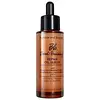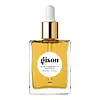What's inside
What's inside
 Key Ingredients
Key Ingredients

 Benefits
Benefits

 Concerns
Concerns

 Ingredients Side-by-side
Ingredients Side-by-side

Water
Skin ConditioningPolysorbate 20
EmulsifyingGlycerin
HumectantPEG-40 Hydrogenated Castor Oil
EmulsifyingPropanediol
SolventOctyldodecyl Citrate Crosspolymer
HumectantHoney
HumectantYeast Extract
Skin ConditioningRaphanus Sativus Seed Extract
Skin ConditioningPyrus Malus Seed Oil
EmollientAleurites Moluccanus Seed Oil
Skin ConditioningHelianthus Annuus Seed Oil
EmollientGlycine Soja Seed Extract
Skin ConditioningHydrogenated Castor Oil/Sebacic Acid Copolymer
EmollientTocopherol
AntioxidantHydroxypropylgluconamide
HumectantHydroxypropylammonium Gluconate
HumectantDihydroxypropyl Arginine Hcl
HumectantPanthenol
Skin ConditioningPolyacrylate Crosspolymer-6
Emulsion StabilisingTartaric Acid
BufferingLinalool
PerfumingCitral
PerfumingLimonene
PerfumingBenzyl Alcohol
PerfumingT-Butyl Alcohol
PerfumingBenzyl Salicylate
PerfumingBenzyl Benzoate
AntimicrobialCaprylyl Glycol
EmollientButylene Glycol
HumectantCoumarin
PerfumingAscorbyl Palmitate
AntioxidantEthylhexyl Salicylate
UV AbsorberEthylhexyl Methoxycinnamate
UV AbsorberParfum
MaskingDisodium EDTA
BHT
AntioxidantPhenoxyethanol
PreservativePotassium Sorbate
PreservativeSodium Benzoate
MaskingWater, Polysorbate 20, Glycerin, PEG-40 Hydrogenated Castor Oil, Propanediol, Octyldodecyl Citrate Crosspolymer, Honey, Yeast Extract, Raphanus Sativus Seed Extract, Pyrus Malus Seed Oil, Aleurites Moluccanus Seed Oil, Helianthus Annuus Seed Oil, Glycine Soja Seed Extract, Hydrogenated Castor Oil/Sebacic Acid Copolymer, Tocopherol, Hydroxypropylgluconamide, Hydroxypropylammonium Gluconate, Dihydroxypropyl Arginine Hcl, Panthenol, Polyacrylate Crosspolymer-6, Tartaric Acid, Linalool, Citral, Limonene, Benzyl Alcohol, T-Butyl Alcohol, Benzyl Salicylate, Benzyl Benzoate, Caprylyl Glycol, Butylene Glycol, Coumarin, Ascorbyl Palmitate, Ethylhexyl Salicylate, Ethylhexyl Methoxycinnamate, Parfum, Disodium EDTA, BHT, Phenoxyethanol, Potassium Sorbate, Sodium Benzoate
Dimethicone
EmollientDimethiconol
EmollientTrisiloxane
Skin ConditioningMel
EmollientPrunus Amygdalus Dulcis Oil
Skin ConditioningCocos Nucifera Oil
MaskingArgania Spinosa Kernel Oil
EmollientPassiflora Incarnata Seed Oil
Skin ProtectingTocopheryl Acetate
AntioxidantParfum
MaskingGardenia Taitensis Flower Extract
Skin ConditioningCI 47000
Cosmetic ColorantTocopherol
AntioxidantCI 26100
Cosmetic ColorantCoumarin
PerfumingHexyl Cinnamal
PerfumingLimonene
PerfumingLinalool
Perfuming
 Reviews
Reviews

Ingredients Explained
These ingredients are found in both products.
Ingredients higher up in an ingredient list are typically present in a larger amount.
Coumarins are a group of substances found naturally in plants. There are over 1300 types of coumarins identified. It has a natural vanilla scent.
Coumarin is an identified EU known allergy, meaning it may cause an allergic reaction when applied to the skin.
In many countries, coumarin is banned as a food additive. However, it can be found in soaps, tobacco products, and some alcohol drinks.
Plants use coumarins as a chemical defense. Some plants that have coumarins include lavender, tonka beans, and yellow clovers.
Learn more about CoumarinLimonene is a fragrance that adds scent and taste to a formulation.
It's found in the peel oil of citrus fruits and other plants such as lavender and eucalyptus. The scent of limonene is generally described as "sweet citrus".
Limonene acts as an antioxidant, meaning it helps neutralize free radicals.
When exposed to air, oxidized limonene may sensitize the skin. Because of this, limonene is often avoided by people with sensitive skin.
The term 'fragrance' is not regulated in many countries. In many cases, it is up to the brand to define this term. For instance, many brands choose to label themselves as "fragrance-free" because they are not using synthetic fragrances. However, their products may still contain ingredients such as essential oils that are considered a fragrance.
Learn more about LimoneneLinalool is a fragrance and helps add scent to products. It's derived from common plants such as cinnamon, mint, citrus, and lavender.
Like Limonene, this ingredient oxidizes when exposed to air. Oxidized linalool can cause allergies and skin sensitivity.
This ingredient has a scent that is floral, spicy tropical, and citrus-like.
Learn more about LinaloolParfum is a catch-all term for an ingredient or more that is used to give a scent to products.
Also called "fragrance", this ingredient can be a blend of hundreds of chemicals or plant oils. This means every product with "fragrance" or "parfum" in the ingredients list is a different mixture.
For instance, Habanolide is a proprietary trade name for a specific aroma chemical. When used as a fragrance ingredient in cosmetics, most aroma chemicals fall under the broad labeling category of “FRAGRANCE” or “PARFUM” according to EU and US regulations.
The term 'parfum' or 'fragrance' is not regulated in many countries. In many cases, it is up to the brand to define this term.
For instance, many brands choose to label themselves as "fragrance-free" because they are not using synthetic fragrances. However, their products may still contain ingredients such as essential oils that are considered a fragrance by INCI standards.
One example is Calendula flower extract. Calendula is an essential oil that still imparts a scent or 'fragrance'.
Depending on the blend, the ingredients in the mixture can cause allergies and sensitivities on the skin. Some ingredients that are known EU allergens include linalool and citronellol.
Parfum can also be used to mask or cover an unpleasant scent.
The bottom line is: not all fragrances/parfum/ingredients are created equally. If you are worried about fragrances, we recommend taking a closer look at an ingredient. And of course, we always recommend speaking with a professional.
Learn more about ParfumTocopherol (also known as Vitamin E) is a common antioxidant used to help protect the skin from free-radicals and strengthen the skin barrier. It's also fat soluble - this means our skin is great at absorbing it.
Vitamin E also helps keep your natural skin lipids healthy. Your lipid skin barrier naturally consists of lipids, ceramides, and fatty acids. Vitamin E offers extra protection for your skin’s lipid barrier, keeping your skin healthy and nourished.
Another benefit is a bit of UV protection. Vitamin E helps reduce the damage caused by UVB rays. (It should not replace your sunscreen). Combining it with Vitamin C can decrease sunburned cells and hyperpigmentation after UV exposure.
You might have noticed Vitamin E + C often paired together. This is because it is great at stabilizing Vitamin C. Using the two together helps increase the effectiveness of both ingredients.
There are often claims that Vitamin E can reduce/prevent scarring, but these claims haven't been confirmed by scientific research.
Learn more about Tocopherol